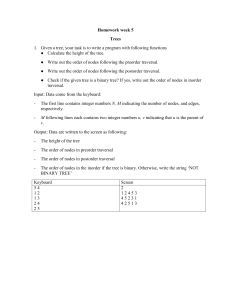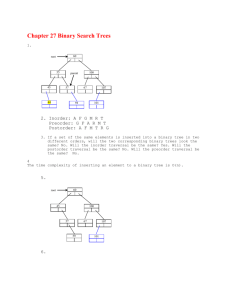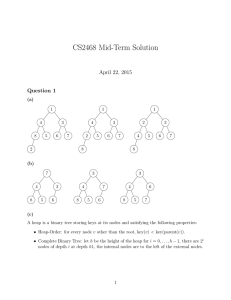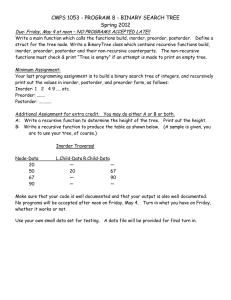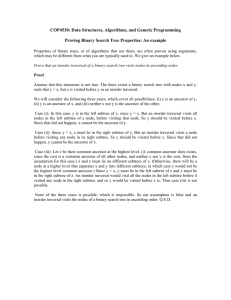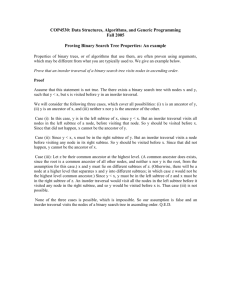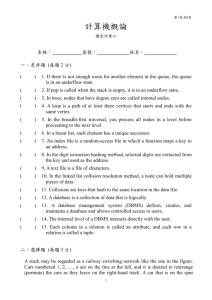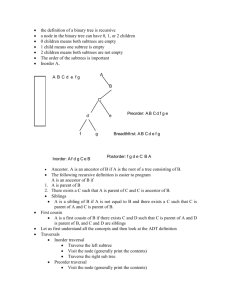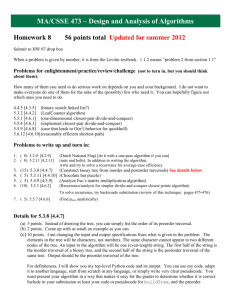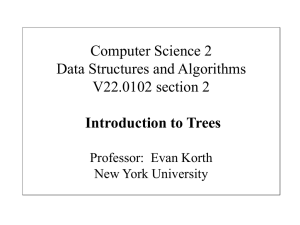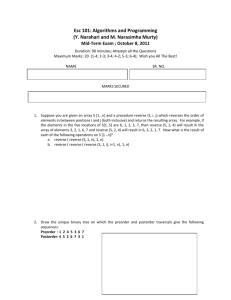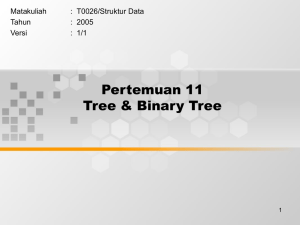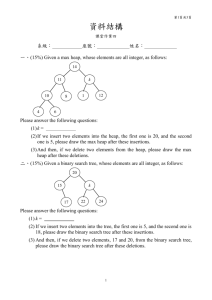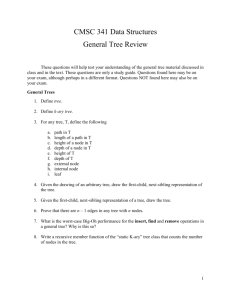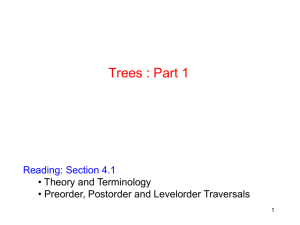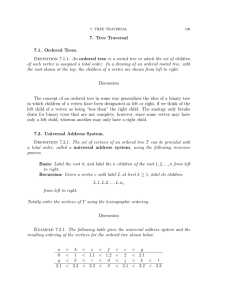doc
advertisement
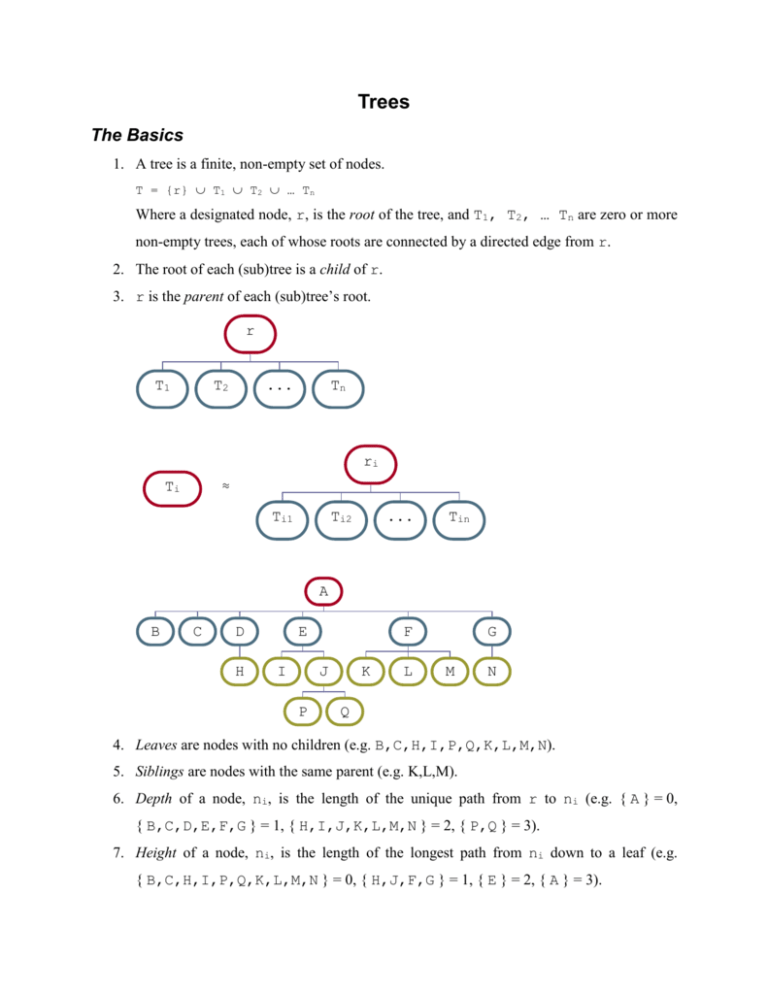
Trees
The Basics
1. A tree is a finite, non-empty set of nodes.
T = {r} T1 T2 … Tn
Where a designated node, r, is the root of the tree, and T1, T2, … Tn are zero or more
non-empty trees, each of whose roots are connected by a directed edge from r.
2. The root of each (sub)tree is a child of r.
3. r is the parent of each (sub)tree’s root.
r
T1
T2
...
Tn
ri
≈
Ti
Ti1
Ti2
...
Tin
A
B
C
D
H
E
I
F
J
P
K
L
G
M
N
Q
4. Leaves are nodes with no children (e.g. B,C,H,I,P,Q,K,L,M,N).
5. Siblings are nodes with the same parent (e.g. K,L,M).
6. Depth of a node, ni, is the length of the unique path from r to ni (e.g. { A } = 0,
{ B,C,D,E,F,G } = 1, { H,I,J,K,L,M,N } = 2, { P,Q } = 3).
7. Height of a node, ni, is the length of the longest path from ni down to a leaf (e.g.
{ B,C,H,I,P,Q,K,L,M,N } = 0, { H,J,F,G } = 1, { E } = 2, { A } = 3).
8. Depth of a tree is equal to the depth of the deepest leaf, and is equal to the height of the
root node.
9. n1 is an ancestor of n2 and n2 is a descendant of n1 if there is a path from n1 to n2 (e.g.
A is an ancestor of all nodes, E is an ancestor of { I,J,P,Q }, J is an ancestor of
{ P,Q }, { P,Q } are descendants of { J,E,A }, J is a descendant of { E,A }, E is a
descendant of A).
Binary Trees
A binary tree is a tree in which no node can have more than two children.
r
TL
TR
ri
Ti
≈
TiL
TiR
Properties of binary trees
1. The depth of a binary tree containing N nodes is at most N-1.
2. The depth of a binary tree containing N leaves is at least [log2(N)].
3. A binary tree of depth d has at most 2d leaves.
4. The number of nodes in a binary tree of depth d is at most 2d-1 - 1.
5. The average depth of a binary tree containing N nodes is Ο Ν .
Tree Traversals
Tree traversal is the process of systematically walking through the tree to visit all the nodes.
A
B
D
C
E
F
H
G
I
Depth-First Traversal
Preorder
Algorithm:
Visit the root first (print).
Do a left-to-right preorder traversal of each subtree.
Code:
Preorder(t)
{
if t == NULL return
visit(t)
Preorder(t->left)
Preorder(t->right)
}
Example:
A,B,C,D,E,F,G,H,I
Inorder (only makes sense for binary trees)
Algorithm:
Do an inorder traversal of the left subtree.
Visit the root (print).
Do an inorder traversal of the right subtree.
Code:
Inorder (t)
{
if t == NULL return
Inorder(t->left)
visit(t)
Inorder(t->right)
}
Example:
B,C,A,F,E,G,D,I,H
Postorder
Algorithm:
Do a left-to-right postorder traversal of each subtree.
Visit the root (print).
Code:
Postorder(t)
{
if t == NULL return
Postorder(t->left)
Postorder(t->right)
visit(t)
}
Example:
C,B,F,G,E,I,H,D,A
Breadth-First Traversal
Algorithm:
Visit all the nodes of depth 0 from left-to-right.
Visit all the nodes of depth 1 from left-to-right.
...
Visit all the nodes of depth n from left-to-right.
Code (uses a queue):
BreadthFirst(t)
{
while t != NULL
visit (t)
if t->left != NULL Enqueue(t->left, q)
if t->right != NULL Enqueue(t->right, q)
if NotEmpty(q)
t = Dequeue(q)
else
t = NULL
}
Example:
A,B,D,C,E,H,F,G,I
